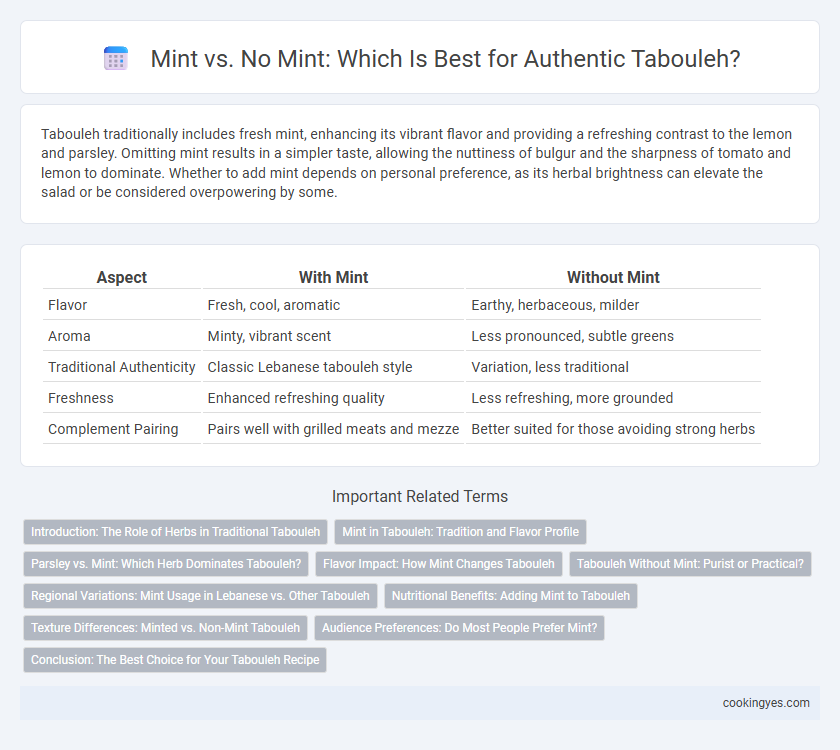Tabouleh traditionally includes fresh mint, enhancing its vibrant flavor and providing a refreshing contrast to the lemon and parsley. Omitting mint results in a simpler taste, allowing the nuttiness of bulgur and the sharpness of tomato and lemon to dominate. Whether to add mint depends on personal preference, as its herbal brightness can elevate the salad or be considered overpowering by some.
Table of Comparison
| Aspect | With Mint | Without Mint |
|---|---|---|
| Flavor | Fresh, cool, aromatic | Earthy, herbaceous, milder |
| Aroma | Minty, vibrant scent | Less pronounced, subtle greens |
| Traditional Authenticity | Classic Lebanese tabouleh style | Variation, less traditional |
| Freshness | Enhanced refreshing quality | Less refreshing, more grounded |
| Complement Pairing | Pairs well with grilled meats and mezze | Better suited for those avoiding strong herbs |
Introduction: The Role of Herbs in Traditional Tabouleh
Traditional tabouleh relies heavily on fresh herbs, with mint playing a crucial role in its distinct, refreshing flavor profile. Parsley remains the dominant herb, but the inclusion of mint adds a cool, aromatic contrast that enhances the salad's vibrant taste and texture. Omitting mint results in a milder, earthier dish that emphasizes parsley's herbal notes over the characteristic brightness mint provides.
Mint in Tabouleh: Tradition and Flavor Profile
Mint is a key ingredient in traditional tabouleh, providing a refreshing and aromatic flavor that balances the parsley and bulgur base. Its distinctive coolness enhances the salad's bright lemon and olive oil dressing, creating a harmonious and vibrant flavor profile. Omitting mint alters the authentic taste and diminishes the characteristic freshness central to classic tabouleh recipes.
Parsley vs. Mint: Which Herb Dominates Tabouleh?
Parsley remains the dominant herb in traditional tabouleh, providing a fresh, slightly peppery flavor that defines the dish's vibrant character. Mint, while optional, adds a cool, sweet undertone that complements parsley and enhances the salad's refreshing quality. Balancing parsley with mint depends on regional preferences, but parsley's earthy brightness is essential for authentic tabouleh.
Flavor Impact: How Mint Changes Tabouleh
Mint transforms tabouleh by adding a refreshing, cooling note that balances the acidity of lemon juice and the earthiness of parsley. Without mint, tabouleh relies more heavily on the herbal sharpness of parsley and the nuttiness of bulgur, resulting in a more straightforward, vegetal flavor profile. The presence of mint elevates the dish with a bright, aromatic layer that enhances its overall complexity and freshness.
Tabouleh Without Mint: Purist or Practical?
Tabouleh without mint emphasizes the purist approach to traditional Levantine flavors, highlighting the vibrant freshness of parsley, bulgur, tomatoes, and lemon juice without the aromatic contrast mint provides. This version appeals to those prioritizing practical simplicity, reducing the ingredient list while maintaining the dish's signature tanginess and texture. Avoiding mint also caters to taste preferences or allergies, making tabouleh more accessible while preserving its essential character.
Regional Variations: Mint Usage in Lebanese vs. Other Tabouleh
Mint is a key ingredient in traditional Lebanese tabouleh, contributing a fresh and aromatic flavor that defines the dish regionally. In contrast, some other Middle Eastern variations either reduce the amount of mint or omit it entirely, emphasizing parsley and bulgur grains instead. This difference reflects cultural preferences and local herb availability, shaping the distinct taste profiles of tabouleh across regions.
Nutritional Benefits: Adding Mint to Tabouleh
Incorporating mint into tabouleh enhances its nutritional profile by providing antioxidants, vitamins A and C, and digestive enzymes that aid in gastrointestinal health. Mint's natural anti-inflammatory and antimicrobial properties contribute to overall immune support and improved digestion. Without mint, tabouleh still offers fiber and essential nutrients from parsley and bulgur, but lacks the unique digestive and antioxidant benefits that mint provides.
Texture Differences: Minted vs. Non-Mint Tabouleh
Tabouleh with mint offers a refreshing, slightly crisp texture that enhances the salad's overall mouthfeel by adding delicate leafiness and a subtle crunch. In contrast, non-mint tabouleh tends to have a softer, earthier texture, relying more on the chewiness of bulgur and the juiciness of tomatoes and parsley. Mint leaves contribute a vibrant, aromatic complexity that lightens the texture, making each bite more dynamic compared to the smoother consistency of tabouleh without mint.
Audience Preferences: Do Most People Prefer Mint?
Most people prefer tabouleh with mint, as its fresh and aromatic flavor balances the tangy lemon and earthy parsley, enhancing the overall taste experience. Mint adds a cooling sensation that complements the dish's traditional ingredients, making it a favored choice in Middle Eastern cuisine. However, some regional variations or personal preferences omit mint to emphasize the natural flavors of bulgur and herbs without added fragrance.
Conclusion: The Best Choice for Your Tabouleh Recipe
Mint adds a refreshing herbal note that complements the tangy lemon and earthy parsley in tabouleh, enhancing its traditional flavor profile. Omitting mint results in a simpler, milder taste, highlighting the bulgur and tomato more prominently. For an authentic and vibrant tabouleh, including fresh mint is the optimal choice.
Mint vs No Mint for Tabouleh Infographic

 cookingyes.com
cookingyes.com